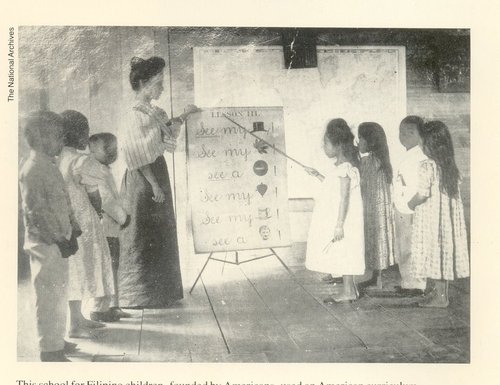For better or worse, American colonial rule has left several legacies in the Philippines, from governmental structure to popular culture. The Pilipino public education system is no exception.
When the United States took control over the Philippines in 1898, one of their first tasks was to implement an Americanized public school system that would educate the Pilipino people and enlighten them about the American way. By 1901, the United States sent over 600 teachers dubbed as “Thomasites.” On the one hand, the shift towards an Americanized public system led to drastically improved literacy rates throughout the Philippines, free primary education for all, and the founding of the University of the Philippines, the nation’s first public university.
On the other hand, controlling the entire country’s education system was another means of maintaining imperial authority over Pilipinos, using the classroom to quell nationalistic ideas and impose Western values. As English became the official language of the Philippines, it also became the primary language of instruction for students over their native tongue. According to psychologist Kevin Nadal, the legacy of the Thomasites continues even today as “most Philippine educational systems have adopted American curricula, although it may not necessarily be culturally appropriate.” The extent of indoctrination that the United States has imposed over the years has stricken many Pilipinos with a colonial mentality through which they learn to value Western ideals over native ones.
In many ways, the purpose for establishing a public education system in the Philippines is similar to the origin of public schools in the United States. The father of American public schools, Horace Mann, believed that “public schools should be means of social control through the teaching of Christian based morals.” This factory-model that the American public school system was founded upon is now being highly contested by education reformers in the United States who argue that the standardization of student learning stifles the creativity and critical thinking skills that are necessary to be competitive in today’s global economy.
As American education reformers are diverging away from the old standardizing model of education, the Philippines is following suit. In 2001, the Philippines adopted a reform program on school-based management, an approach that decentralizes the public education system and empowers local school officials to charge their own curriculum design and administration. School-based management has been shown to “yield various positive results such as improved academic performance of students [and] increased participation of parents and the community.”
In 2002, the Makabayan curriculum was introduced to improve critical and creative thinking development and promote Pilipino values. Makabayan is described as “a learning area that serves as a practice environment for holistic learning to develop a healthy personal and national self-identity” and includes subjects such as social studies, music, health education, and values education.
So what might this mean for the upcoming generations of young educated Pilipinos? We can hope that these reform efforts will develop proud citizens who value the strengths of their culture and confidently skilled students who will help propel the Philippines into a world player. Of course, when it comes to the complex issue of education there are still loads of problems waiting for solutions, from resources to poverty and accessibility. Perhaps this is at least one step in the right direction.
Photo Credit: philippines1900.tumblr.com



